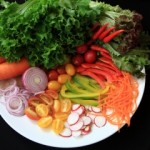What exactly is couscous?
I only started eating couscous a few years ago – I expect that’s the same for a lot of people. It was only after I’d had it a few times that I started wondering exactly what it was. Obviously it’s some kind of starchy carbohydrate, but it didn’t quite seem like anything else I’d had – rice or pasta say.
However a little bit of research tells me that couscous is made from semolina and durum wheat flour. Semolina is the hard part of the durum wheat kernel. The semolina grains are combined with water, and then rolled in the flour to keep them separate.
Durum wheat is ground into durum flour and is used to make pasta, which is why couscous is generally considered as part of the pasta family. It’s traditionally made in North Africa, hence today we tend to think of couscous as being Moroccan.
Couscous is great because it’s so easy to cook – you basically soak it in boiling water for 5 minutes and its done.
I found this nice stock photo of a lady making couscous in the traditional way.
So I thought I was sorted – until I bought a pasta salad dish from the supermarket which contained what I dubbed “big couscous”. I couldn’t see where to buy packets of it dried, and wondered what on earth it was.
 Apparently this couscous is Israeli couscous and in Israel itself its called Ptitim. Again its a type of pasta shaped into small balls. I’ve only ever seen it in one or two supermarket ready made salads but its very nice.
Apparently this couscous is Israeli couscous and in Israel itself its called Ptitim. Again its a type of pasta shaped into small balls. I’ve only ever seen it in one or two supermarket ready made salads but its very nice.
I’d like to have a go at making big couscous for myself – hopefully its as easy to cook as the small kind, but I haven’t yet seen it on the supermarket shelves so that’s something to look out for.
Tags: couscous













